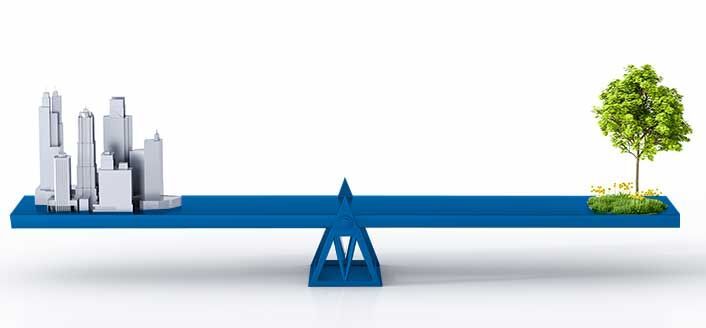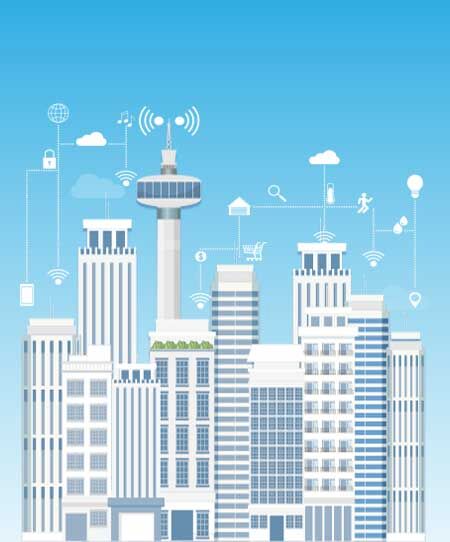The global commercial real estate industry has been steadily expanding for the past decade. According to a report published by Statista, $89.52 billion worth of commercial buildings were put in place in the United States alone in 2018. However, as the business landscape continues to evolve, developers and landlords are beginning to see new demands in building construction.
Tenants and employees are looking for office spaces that foster collaboration and can adapt to their changing workflows. Connectivity also is a driving factor; a survey conducted by WiredScore discovered that 75% of tenants consider poor internet connectivity to impact company profitability, and 84% of tenants would pay more per square foot for their space if an owner could prove a building has reliable connectivity.
Also in demand are buildings that are certified by the Leadership in Energy and Environmental Design (LEED) program. Dodge Analytics annual World Green Building Trends report revealed nearly half of developers in the study regions expect to build the majority of their projects green by 2021. According to another Statista report, the number of LEED-certified projects in the United States rose from 296 certifications in 2006 to more than 65,000 in 2017. To answer these demands for superior connectivity, optimized management systems, and energy efficiency, developers have utilized the Internet of Things (IoT) and green design practices to develop smart buildings.
Smart buildings offer enhanced tenant relationships, increased building safety, and dynamic work spaces that engage with employees to spur productivity and promote worker well-being. While smart buildings currently hold a relatively small portion of the commercial building market, they represent the future of commercial real estate. According to an MIT Center for Real Estate report, which analyzed data from more than 650 smart and non-smart buildings in New York City, tenants in smart buildings are willing to pay 37% higher rent on average.
Below are three examples of smart buildings in use today. Each of these buildings illustrate the benefits for workers in the long term, and serve as guideposts for developers who want to take advantage of IoT connectivity to present a unique commercial offering.
The Edge, Amsterdam: The Greenest Building in the World
Since its opening in 2015, the Edge has been deemed the smartest, greenest building in the world. According to British sustainability assessment agency BREEAM, the Edge uses 70% less electricity than comparable office buildings. Both the roof and the south-facing facade of the Edge incorporate an array of photovoltaic panels to collect solar energy (the largest of any European office building), and a thermal energy storage aquifer system provides all of the energy required for heating and cooling the building. The Edge also has incorporated homes for bats and beehive towers, becoming an active contributor to local conservation efforts.
Aside from these green features, the Edge is itself an all-encompassing IoT ecosystem that offers a dynamic workspace for its tenants. The parking garage recognizes a tenants car when it arrives and directs them to the optimal parking spot. Interacting through a smartphone app developed by the Edges marquee tenant, Deloitte, employees check in when they arrive and are directed to one of several open desk options based on their work schedule for the dayfrom a standard sitting desk to standing desks, work booths, meeting rooms, balcony seats, or rooms tailored for deep concentration. The Edges dedicated smartphone app also knows each employees preference for light and temperature, tweaking their environment accordingly when they enter their workspace.
Cisco Canada Headquarters, Toronto: Productivity, Efficiency, and Collaboration
Similar to the Edges dynamic workspaces, employees at Cisco Headquarters in Toronto dont have permanently assigned desks. When a worker arrives, a smartphone app directs them to a workstation that automatically syncs with their comfort and lighting preferences. The goal is to promote greater flexibility and collaboration between employees. Smart meeting spaces and common areas adjust to employee needs, and conference rooms have retractable walls that can combine and open up spaces for large meetings or training sessions.
Cisco Headquarters is LEED Core and Shell Platinum certified and boasts a number of IoT-driven efficiency systems that reduce energy usage and operating costs. For example, its smart elevator system is designed to reduce the number of energy wasting empty rides. Rather than pushing a button to go up or down, tenants select the floor theyre going to when they approach an elevator bank, and the system will select the car that is closest to their current location, taking the tenant to their floor with a minimal amount of empty ride time.
Capital Tower, Singapore: Promoting Worker Health and Safety
Built in 2000, Capital Tower is the oldest building on this list, but it still features a host of smart features that promote energy efficiency and connectivity. Capital Tower was the first office building in Singapore to provide a wireless local area network (WLAN) throughout the entire building. Energy efficient features, such as smart lighting, greatly reduce the buildings operating costs and carbon footprint, and the HVAC system within the building utilizes an energy recovery wheel that recovers cool air to maintain the chillers efficiency.
Beyond reliable connectivity and energy efficiency, Capital Towers smart systems promote wellness by ensuring superior air quality. IoT sensors evaluate factors such as temperature, humidity, and carbon dioxide concentration to maintain optimal balance for both productivity and health. In the parking garage, a set of sensors constantly are measuring carbon monoxide levels and will trigger an exhaust fan system whenever pollution levels reach certain thresholds. This cost-effective response mechanism helps mitigate health hazards while reducing wasteful energy spending when garage traffic is low and external air quality is good.
Deploy IoT in Your Smart Building with Aeris
Commercial real estate is set to enter a new era in the age of IoT. From LEED-certified green building practices to smart systems that monitor building conditions for optimal efficiency, tomorrows commercial tenants will require spaces that can adapt to their dynamic needs and offer reliable connectivity wherever employees are working. In order to capitalize on these new demands, developers require an IoT infrastructure that is purpose-built, scalable, and fully customizable.
Aeris offers commercial developers a future proven connectivity solution. Our IoT infrastructure services provide the tools and analytics to help commercial landlords manage and monitor their entire system at any scale. Integrating advanced tools, network level security protections, moving data, and other asset management solutions, Aeris provides optimal connectivity and real-time system monitoring that forms the backbone of any smart building.
To learn more about Aeris and start designing your next smart building, contact us today.




